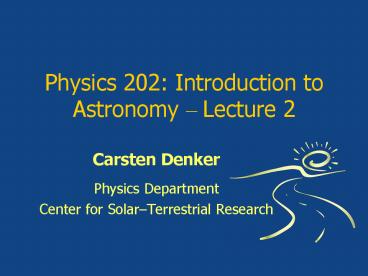Physics 202: Introduction to Astronomy - PowerPoint PPT Presentation
1 / 12
Title:
Physics 202: Introduction to Astronomy
Description:
North and south celestial poles. Celestial equator. Celestial coordinates ... Long-Term Changes ? Precession. January 20, 2006. Center for Solar-Terrestrial Research ... – PowerPoint PPT presentation
Number of Views:63
Avg rating:3.0/5.0
Title: Physics 202: Introduction to Astronomy
1
Physics 202 Introduction to Astronomy Lecture 2
- Carsten Denker
- Physics Department
- Center for SolarTerrestrial Research
2
Prologue
- Constellations
- Celestial sphere
- North and south celestial poles
- Celestial equator
- Celestial coordinates
- Declination and right ascension
- Solar and sidereal day
- Ecliptic
- Zodiac
- Seasons
- Summer and winter solstice
- Vernal and autumnal equinox
- Tropical and sidereal year
- Precession
3
Constellations in the Sky
4
Celestial Coordinates
5
Solar and Sidereal Day
6
Long-Term Changes ? Precession
7
Group Problem
- How and why does a day measured by the Sun differ
from a day measured by the stars? - Assume that the Earth would orbit the Sun in the
opposite direction. How would that affect the
solar and sidereal day?
8
The Orbit of the Moon
- Phases
- New, quarter, and full Moon
- Sidereal month (27.3 days) and synodic month
(29.5 days) - Solar and lunar eclipses
- Total, annular and partial solar eclipse
- Umbra and penumbra
9
Lunar Phases
10
Lunar Eclipse
11
Solar Eclipse
12
Group Problem
- Why arent there lunar and solar eclipses every
month































